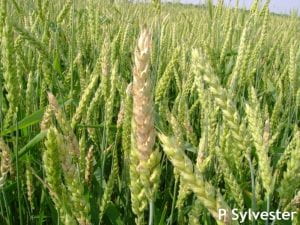Nathan Kleczewski, Extension Specialist – Plant Pathology; nkleczew@udel.edu
Disease models at http://www.wheatscab.psu.edu/ currently are listing much of Kent County and portions of Sussex County as being at high risk for FHB (See photo below). Growers in these regions should consider applying appropriate fungicides (Prosaro, Caramba, Proline) if wheat is at early flowering (Feekes 10.5.1). All growers should continue to monitor the growth stage of your wheat and the wheat scab modeling website to determine if and when fungicide applications may be needed. See last week the article below for more information on FHB management.
Original Article:
We are entering the period where outbreaks of Fusarium head blight are possible on winter wheat. This disease is caused by a fungus (predominantly Fusarium graminearum) that resides in crop residue (corn stalks, wheat straw, and other host plants). The fungus produces spores on this residue, which are dispersed by rain or wind to the flowering wheat. Once wheat is infected, wheat heads may become bleached (Figure 1) and pink to orange fungal growth may be seen at the base of diseased spikelets. The fungus also produces mycotoxins such as vomitoxin (aka: DON), which are toxic to humans and animals and can be present in infected wheat grain. In this article I will go over some important factors that impact head blight severity and discuss fungicide use to help suppress this disease.
Growers should consider applying fungicides to wheat if the environment favors disease and plants are in a susceptible growth stage. Over the past two weeks Delaware has experienced wet weather associated with persistent cool temperatures. The cool temperatures likely have slowed the development of Fusarium spores and the risk for severe head blight outbreaks. However, the risk for head blight will rise if moisture remains high (>90% RH) and temperatures increase. Optimal temperatures for head blight infection are between 59 and 86°F. I encourage all growers to visit the FHB Risk assessment tool at http://www.wheatscab.psu.edu to keep abreast of the blight risk in their area. As of May 7th, the forecasting model shows a small section of southeast Sussex County with moderate to high levels of head blight risk.
The severity of Fusarium head blight is not only impacted by weather, but also by the growth stage of the plant. Fusarium infections are most severe at flowering; consequently, this is when you should apply a fungicide. Fungicide treatments will be most effective if applied preventively at early flowering. A link to identifying this stage in wheat can be found at http://www.youtube.com/watch?v=7NJNE1wbVaU. Fungicides applied earlier or later will be ineffective at controlling this disease. In addition, fungicides applied before heading or at the flag leaf stage will not provide scab control. Even if timed properly and applied preventively, a fungicide may only result in approximately 50% disease control. However, the goal of a fungicide application is to reduce the impact of this disease on yield and to reduce mycotoxin levels in grain. Therefore, it is important that you choose the correct fungicides to maximize the benefit of the fungicide treatment.
 Figure 1. An example of head bleaching that may occur from infection by the Fusarium head blight/scab fungus.
Figure 1. An example of head bleaching that may occur from infection by the Fusarium head blight/scab fungus.
What fungicides should you apply? The best fungicides for control of head scab belong to the triazole class of fungicides (Group 3), but they vary greatly in their level of activity. The two best products for wheat head scab control are Caramba™ (active ingredient: metaconazole) and Prosaro™ (active ingredients: prothioconazole+tebuconazole). Proline™ (active ingredient: prothioconazole) provides some control but often is not as effective as Prosaro™. Products containing only tebuconazole (e.g. Folicur™) have been used in the past to control head blight. However, research from The Ohio State University indicates that Caramba™ and Prosaro™ provide between 10 and 15% greater control of blight, and between 20 to 25% greater control of DON than Folicur™. The nice thing about Caramba™ and Prosaro™ is that they will also give you some control of Septoria/Stagonospora glume blotch, rust, and tan spot. Fungicides containing a strobilurin (group 11) should not be applied to heads or flowers because strobilurins may increase DON levels in grain. Examples of these products include Quadris™ Headline™ Stratego™ and Quilt™.
In closing, remember that fungicides are only one part of Fusarium blight management and work best when combined with other practices. There are several options that you have to proactively reduce the risk of head blight. These include using resistant wheat varieties, tilling, removing crop debris from the field, and spreading risk by planting several varieties at different dates. Even if these management practices are followed, head scab outbreaks are possible given the right environmental conditions. Visit the FHB risk assessment tool often and monitor the growth stage of your wheat to determine if and when a fungicide treatment is needed. I encourage growers to contact University of Delaware Extension personnel to assist with your wheat disease management needs. Additional information on Fusarium head blight management can be found at http://www.scabsmart.org/ and http://www.apsnet.org/edcenter/intropp/lessons/fungi/ascomycetes/Pages/Fusarium.aspx.
